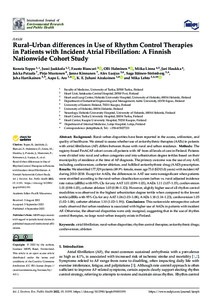Rural-Urban differences in Use of Rhythm Control Therapies in Patients with Incident Atrial Fibrillation: A Finnish Nationwide Cohort Study
Teppo Konsta; Jaakkola Jussi; Biancari Fausto; Halminen Olli; Linna Miika; Haukka Jari; Putaala Jukka; Mustonen Pirjo; Kinnunen Janne; Luojus Alex; Itäinen-Strömberg Saga; Hartikainen Juha; Aro Aapo L; Airaksinen KE Juhani; Lehto Mika
https://urn.fi/URN:NBN:fi-fe2022112967789
Tiivistelmä
Background:
Rural-urban disparities have been reported in the access, utilization, and quality of healthcare. We aimed to assess whether use of antiarrhythmic therapies (AATs) in patients with atrial fibrillation (AF) differs between those with rural and urban residence.
Methods:
The registry-based FinACAF cohort covers all patients with AF from all levels of care in Finland. Patients were divided into rural and urban categories and into urbanization degree tertiles based on their municipality of residence at the time of AF diagnosis. The primary outcome was the use of any AAT, including cardioversion, catheter ablation, and fulfilled antiarrhythmic drug (AAD) prescription.
Results:
We identified 177,529 patients (49.9% female, mean age 73.0 (SD13.0) years) with incident AF during 2010-2018. Except for AADs, the differences in AAT use were nonsignificant when patients were stratified according to the rural-urban classification system (urban vs. rural adjusted incidence rate ratios (aIRRs) with 95% CIs for any AAT 1.01 (0.99-1.03), AADs 1.11 (1.07-1.15), cardioversion 1.01 (0.98-1.03), catheter ablation 1.05 (0.98-1.12)). However, slightly higher use of all rhythm control modalities was observed in the highest urbanization degree tertile when compared to the lowest tertile (aIRRs with 95% Cis for any AAT 1.06 (1.03-1.08), AADs 1.18 (1.14-1.23), cardioversion 1.05 (1.02-1.08), catheter ablation 1.10 (1.02-1.19)).
Conclusions:
This nationwide retrospective cohort study observed that urban residence is associated with higher use of AADs in patients with incident AF. Otherwise, the observed disparities were only marginal, suggesting that in the use of rhythm control therapies, no large rural-urban inequity exists in Finland.
Kokoelmat
- Rinnakkaistallenteet [27094]
